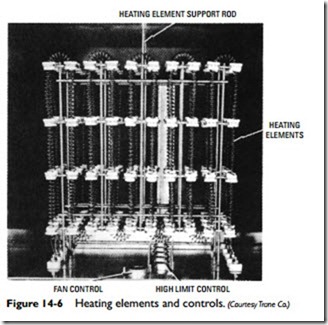Heating Elements
A heating element must operate at a temperature well above its surroundings to deliver heat at a useful high rate. If it is a radiant heating element, it may operate red-hot or nearly white-hot over a relatively long period of time.
Wires with a high resistance, such as iron, chromium, nickel, man- ganese, and their alloys, are commonly used for heating elements. The heat output of a wire can be varied by changing its material composition or by changing its size or diameter. A smaller-diameter wire will have a higher resistance than a larger-diameter wire.
The heating elements in an electric furnace are resistance coils made from high-temperature chrome nickel heat-generating wire. Most manufacturers design their furnaces so that the entire heating element assembly can be removed for easy maintenance or repair (Figure 14-6).
Open elements are used in noncentral heating units, such as radiant or convective heaters, where it is desirable for the element to operate at a relatively high temperature. These elements reach operating temperatures very rapidly when energized. The exact operat- ing temperature depends on the material used in the element and the type of heat desired. A radiant heater, for example, would prob- ably operate at higher temperatures than would a wall-mounted convective heater.
Another type of element used in noncentral heating is the encapsulated, or completely enclosed, element. The simplest form of encapsulated element is ceiling cable, which has a layer of plastic insulation over it that can withstand the heat. Ceiling cable is designed to operate at very low temperatures.
A more complicated enclosed element is that used in base- board convectors. An outer sheath of ceramic or metal protects the resistance wire from damage, corrosion, and deterioration. The
heat-dissipating fins add surface area to increase the rate of heat transfer to the surrounding medium (air or water).
